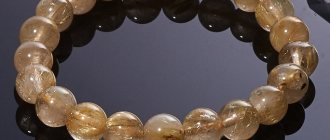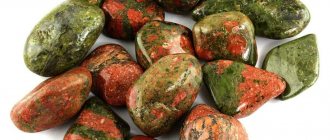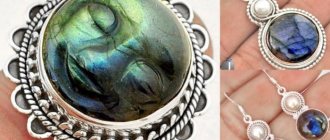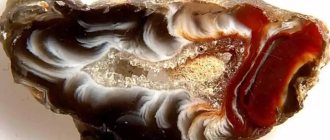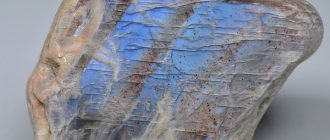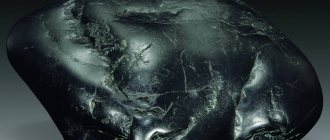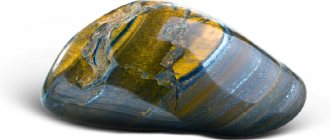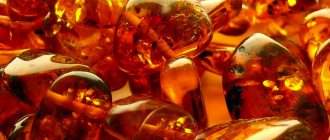| Category | Silicate minerals |
| Title in English | Actinolite |
| Formula | Ca2(Mg,Fe)5(OH)2 |
| Group | Group of amphiboles of the silicate class |
| Color | Green, Black |
| Stroke color | White |
| Shine | Glass |
| Transparency | Translucent, Transparent |
| singonia | Monoclinic |
| Hardness | 5,5 — 6 |
| Cleavage | Perfect |
| Density, g/cm³ | 2.9 - 3.3 g/cm³ |
| Kink | Splintered, Stepped |
| origin of name | If you hold actinolite under sunlight, you can see the beautiful shimmer of all its facets. For this feature, the stone received a name that combines the Greek words aktinos - ray and lithos - stone. The official name was given to the gem in 1974. |
| Morphology | The structure of the stone is in the form of elongated plate-like crystals, reaching a length of up to 15 cm. The crystals can be curved. They range from radial fibrous to asbestos-like and from granular to massive. |
The mineral actinolite is a silicate containing iron. It is painted in gray-brown-green colors and consists of a large number of needle crystals, which give the stone radiance and shine, which is why it got its name “radiant”. Along with actinolite, garnet, quartz, talc, and epidote are often mined. This gem is used in jewelry, and its elastic variety is used to make rubber for tires.
Actinolite deposits
Actinolite is a common mineral, deposits of which are not uncommon.
Its most significant deposits were found in Russia (Urals, Karelia, Primorsky Krai, Yekaterinburg), as well as in countries such as Austria, the USA, Brazil, China, Canada and New Zealand. — Advertising —
Transparent actinolite is mined in Africa, and deposits of blue-gray stone are located in Italy. High quality crystals for making jewelry come from Tanzania and the northern regions of India. Instances of ornamental quality were found on the territory of Ukraine in the Azov region.
Switzerland, Slovakia, Afghanistan and Madagascar also began to develop actinolite deposits.
Place of Birth
Natural deposits of actinolite are located in Canada, the USA, Brazil, Austria, Italy, Switzerland, Tanzania, Madagascar and Ukraine. In Russia, the mineral is found in the Southern Urals and Transbaikalia.
Actinolite forms into matted fibrous or columnar aggregates. Associated minerals include garnet, talc, quartz and epidote.
History of actinolite
Actinolite has been known since ancient times, but was described and given its name in 1794.
The Greek words "actinos" and "lithos" are translated as "ray" and "stone", that is, the literal translation of the name of the mineral is radiant stone, which indicates shiny, shining crystals made in the form of rays. After some time, various types of actinolite were discovered and described, each of which received a separate name.
Chemical composition
The chemical composition of actinolite, taking into account isomorphic substitutions, is expressed by the formula: (Na, K)0-0.5 (Ca2-1.34 Na0-0.66) [(Mg, Mn, Al, Ti)4-2.5(Fe2+, Fe3+ )1-2.5] [(Si8-7.5 Al0-o.5) (O, OH)22] (OH, F, Cl, O)2.
Theoretical compositions:
Ca2Mg4FeSi8O22(OH)2: CaO - 13.29; MgO - 9.11; FeO - 8.51; SiO2 - 56.96; H2O - 2.13.
Ca2Mg2.5 Fe2.5 Si8O22(OH)2: CaO - 12.59; MgO - 11.31; FeO - 20.15; SiO2 - 53.93; H2O - 2.02.
CaO content from 9.3 to 13%; Unlike tremolites, Ca is often replaced by Na and group Y cations, especially in actinolites from glaucophane-containing rocks. Actinolites are known that are transitional to cummingtonites. MgO - usually from 12 to 20%, sometimes reduced to 9.5% (transition to ferroactinolites). Higher contents are possible with significant replacement of Ca by Mg. The total amount of Fe is conditionally limited to the range of 1-2.5 per formula unit, but actinolites with Fe>175 are rare. FeO from 7 to 19%, Fe2O3 in the range of 0-5.5%. MnO from 0.15 to 0.55% (Mn0.02-0.07), rarely less or not detected; An increased MnO content was found in actinolite from the iron ore region of northeastern Labrador and in bissolite from an alpine-type vein at the Puiva deposit in the Urals. Manganese actinolite contains up to 7.4% MnO. Always contains small amounts of alkali metals. The Na2O content usually does not exceed 1%, but with a low calcium content it can reach 5.0%. The K2O content is no more than 0.65%, the highest in actinolites from aureoles of granitoid intrusions, the lowest in actinolites from glaucophane-containing rocks and ferruginous quartzites. The amount of Na + K is from 0.03 to 0.60, sometimes more, their amount in position A of the structure is up to 0.32. Al2O3 - no more than 5%, absent in some actinolites. Cr2O3 is rarely observed, as is P2O5. SiO2 content is in the range of 51-56%. TiO2 up to 0.3-0.8% (up to Ti0.08); F—up to 0.3%, rare; Cl was detected only in actinolites from iron ore deposits.
Varieties
By composition:
Manganese actinolite - manganous actinolite. Discovered in skarns of the Kaso manganese deposit (Japan). Contains up to 7.38% MnO. Its properties are indistinguishable from ordinary actinolite. The most ferruginous manganese actinolite, dark green to gray-green, forms veins up to 5 cm thick, composed of irregular, partly elongated grains, contains inclusions of orthite, and is associated with lemon-yellow garnet. Less ferrous manganese actinolite in the form of colorless crystals was found as a product of hydrothermal alteration of skarn rhodonite; associated with brown garnet and manganphlogopite; some of its secretions are contained in hyalophane crystals.
Actinolite. Fiber aggregate
By the nature of the release:
Actinolite - asbestos - actinolite-asbeste - parallel-fiber actinolite. It differs from tremolite-asbestos in its higher iron content. Synonyms like tremolite-asbestos. Actinolite-asbestos deposits are confined to zones of intense fracturing in altered basic volcanic rocks. Asbestos formation is associated with hydrothermal activity in areas of granite magmatism. Asbestos is contained in veins and veins that are not consistent along the strike, often irregular and with bulges. The length of the zones is up to hundreds of meters. Asbestos is cross- and longitudinally fibrous, the length of the fibers is up to 30 cm. Association with quartz, calcite, albite, epidote, axinite, and sometimes with ore minerals is typical. Small veins are usually monomineral. Examples of deposits: Grushinskoye (Yalta) in Northern Kazakhstan, Kyshgauzskoye in Central Kazakhstan, Gorbunovskoye in the Urals, Khatsavinskoye in the North Caucasus, Chazadyr in Tuva, Esenbulak in Mongolia. Actinolite-asbestos veinlets are also present in the hornfelsed sand-shale oligoclase-chlorite-epidote-actinolite rocks of Ak-Sika, Tuva Aut. region; in apogabbro chlorite-actinolite schists of the Tarcin region (Yugoslavia); in brecciated copper-nickel ore of the Allarechenskoye deposit on the Kola Peninsula. It is used, like tremolite-asbestos, for the manufacture of insulating and acid-resistant materials, but is inferior in quality. As the iron content increases, solubility increases, especially after heating at temperatures above 700°.
Actinolite-byssolite (Saussure, 1796) is a tangled fibrous actinolite. Synonym. Actinolitic zillerite (Fersman, 1913). It differs from tremolite-bissolite in its increased iron content. Formed by hydrothermal alteration of basic rocks, gneisses, and crystalline schists; known in quartz veins; in the voids it envelops crystals of calcite, quartz, magnetite, titanite, albite, pennine, epidote, native silver, prehnite, pyrite, chalcopyrite; fibers are partially included in quartz and calcite crystals. Known in an Alpine-type vein in Puiva in the Subpolar Urals; in voids of desilified pegmatite and in veinlets among amphibolites in association with albite and scapolite in the Emerald Mines in the Urals; with epidote, calcite and grossular in the Kansai skarn lead-zinc deposit, Kuramin Mountains (Uzbekistan); in the voids of the garnet skarn in Mladenov (Bulgaria) it grows on epidote, quartz and calcite with siderite, limonite, desmin, chalcopyrite; in quartz veins cutting gabbroids in the Radautal valley, Harz (Germany); in the alpine veins of the Maderanertal valley (Switzerland); in Allermont (France); in South Oran (Algeria); in Buckingham (Canada).
Jade is a dense cryptocrystalline mass composed of intertwined actinolite needles.
Uralite
Physico-chemical characteristics of actinolite
— Advertising —
Iron and silicon are the predominant elements in the composition of actinolite; depending on their percentage content, the color of the mineral changes. Impurities include compounds of titanium, aluminum, potassium, manganese and magnesium.
The crystals have a monoclinic system, the shape is needle-shaped or columnar, elongated. The color range ranges from green, greenish-gray to black. The stone is transparent or translucent. It has a glassy, pronounced shine. In some specimens there is a “cat’s eye” effect due to the shine of thread-like thin fibers.
At the fracture, the actinolite is uneven. It has medium cleavage, hardness 5-6. The density is 3.03-3.24 g/cm3. This mineral is quite fragile, but resistant to acids, slightly soluble only in hydrochloric acid.
Chemical and physical properties
The basis of the mineral is silicon and iron, which play an important role in the formation of the color range of the stone. Also noteworthy is a small amount of titanium, aluminum, manganese, magnesium, and potassium. The specimens are very fragile, of medium hardness and tolerate acids well. Given the thin fibers, similar to threads, some samples acquire amazing iridescence, like a cat's eye.
Actinolite at fractures has an uneven structure. On the hardness and compliance scale -5.
Chemical formula: Ca2(Mg,Fe)5[Si8O22](OH)2
Types of actinolite
The following subspecies of actinolite are distinguished according to their color:
- Jade - in addition to iron, contains chromium and manganese, due to which it is characterized by the widest palette of colors: from almost white through yellowish-green, grass, emerald, swamp green to black. Blue and red varieties are rare and most valuable.
- Bissolite is a fine-fiber mineral of greenish or green-gray color, deposits of which are located in the Alps. It got its name because of its external resemblance to flax fibers.
- Smaragdite is a rare bright specimen, the rich color of young grasses.
- Amianth is an actinolite of violet tones without dark spots.
Varieties
Actinolites are classified by composition and shades.
The following types of mineral are distinguished by shade:
- Amyantus. Specimens of violet shades, without dark spotting.
- Nephritis. The number one stone for the Celestial Empire.
- Smaragdite. Transparent, emerald green.
Actinolites are distinguished according to their dominance in the composition of a particular element:
- Manganese. A typical specimen is dark green in color with randomly distributed veins. Sometimes there is a grayish-brown spotting. Stones with a lower percentage of manganese are colorless or brownish.
- Asbestos. Actinolite, saturated with iron, with a parallel-fibrous structure of asbestos veins. Popularly known as the hairy one.
Bissolite appears in both classifications. This is a bright actinolite with a fine-fiber structure, shades of young greenery. Rare, valuable, found only in the Alps.
The magical properties of actinolite
In ancient times, actinolite was often used by enlightened magicians, shamans and sorcerers for rituals and ceremonies, and each nation associated its own signs and legends with this gem.
On the African continent, actinolite was used to identify liars, because they believed that a change in aurora indicated who was deceiving. The stone was used in justice: if it faded in the hands of the accused, it was believed that this indicated deception and the person was found guilty.
The Chinese believed that the discovery of an actinolite crystal was a very bad omen, and it was considered even more unfavorable to bring the mineral into your home. They believed that actinolite took on the fate and energy of its former owner. Thus, picking up a mineral along the way, along with it, a person also took the fate of its owner.
At the same time, the inhabitants of the Urals, where large deposits of actinolite are located, endowed the stone with a number of opposite properties. So, they believed that actinolite brings treasures, good luck, and the fulfillment of cherished desires.
Today, actinolite is considered a symbol of ambition, decency, wisdom, courage, and loyalty. It is believed that the mineral contained in the talisman is the key to positive changes in the life of the owner.
Crystallographic characteristics
Syngony. Monoclinic.
Crystal structure
Isostructural with tremolite; Mg in octahedral positions is partially replaced by Fe2+. Typically, the M(2) positions are depleted in Fe2+ compared to M(1) and M(3). The distribution of iron between the M(1) and M(3) positions may be different.
Actinolite crystals with talc. North Caucasus
Form of actinolite in nature
The crystals are needle-shaped, prismatic.
Twins at (100) are simple and polysynthetic. There are indications of twinning along (010) and (101).
Aggregates . Granular masses, porphyroblasts, columnar and radiant aggregates, parallel fibrous (asbestos) and tangled fibrous (bissolite) deposits.
The healing properties of actinolite
The main use of actinolite is related to the treatment of skin diseases.
To do this, combine the mineral with silver, since its properties increase significantly. When the skin peels, wear a ring with actinolite on the right hand. Paired bracelets worn on both hands help to cope with ringworm, skin fungus and eczema. For problems with the scalp and hair, wear silver earrings with this gem. In general, actinolite has a positive effect on the entire body.
Thus, it improves the functioning of the cardiovascular system, respiratory system, digestion, bones and joints. In folk medicine it is used to restore potency. Actinolite crystals of a green hue are indicated for the treatment of mental problems.
Origin and location
Metamorphic - in skarns (in contacts with limestones), found in crystalline schists (talc, chlorite). Sometimes it is the main rock-forming mineral (actinolite shales).
Actinolite is a rock-forming mineral of metamorphosed mafic rocks of the greenschist facies, found in hydrothermally altered igneous and metamorphic rocks, sometimes associated with the processes of formation of magnetite or copper-nickel ores.
During the metamorphism of basic volcanic-sedimentary and subvolcanic rocks, actinolite is formed in association with albite, epidote and chlorite, mainly along dark-colored minerals, but also replaces plagioclase. At the initial stages of metamorphism of volcanic-sedimentary rocks, detrital grains of hornblende are overgrown with actinolite, and fine-needle actinolite is released in the cement. In volcanogenic rocks, actinolite replaces phenocrysts of dark-colored minerals. During regressive metamorphism and in the process of metasomatism, actinolite is formed from dark-colored minerals of igneous and metamorphic rocks of basic, less often intermediate composition; in tectonically weakened areas it is deposited to form veins and nest-like accumulations, for example, in the Urals, on the Kola Peninsula, in Central Japan. Actinolite-asbestos veins are also found in fracture zones in the main rocks. During intense metamorphism, actinolite and albite-epidote-actinolite schists with chlorite, calcite, and sometimes muscovite are formed. However, actinolite hornblende is more common in shales than actinolite. In greenschist strata, the albite-epidote-actinolite association is characteristic of zonal complexes and halos of granitoid intrusions. When moving to higher temperature associations of the amphibolite facies, zoned amphibole crystals appear with a core of relict actinolite and a shell of more intensely colored (often blue-green) hornblende. Zonal metamorphic complexes with actinolite as a rock-forming mineral are known in New Zealand, Scotland, and the Abukuma Plateau in Japan. In the Southern Urals, albite-epidote-actinolite rocks form a narrow cutting zone along the main volcanic rocks, pyroclasts and terrigenous-sedimentary rocks. The transition zone to unaltered rocks has a quartz-chlorite composition. The intensity of metamorphism and the amount of actinolite increase in dislocation zones, where a gradual transition to metasomatic rocks with pyrite mineralization is observed. Acicular and asbestos-like actinolite is found in pyrite deposits. Actinolite is found in halos of granitoid intrusions in California, the USA, South America, Tuva and other areas. In some places, the mineral is found in zones of contact between granitoids and volcanic-sedimentary or metamorphic rocks, for example, in the river basin. Tutkhun in Azerbaijan it is part of various hornfels of volcanic-sedimentary rocks; in the area of the Emerald Mines in the Urals, it forms dense clusters and lens-shaped bodies up to 2.5 m long in the phlogopite zone of desilified pegmatites, composes reaction zones at the contact of diorite with serpentinites; in the area of the Złoty Stock gold deposit in Lower Silesia (Poland), it is developed in amphibolites near the contact with granitoids. In an unusual paragenesis with biotite, K-feldspar, plagioclase and quartz, actinolite is found in the Durbachites of the Central Bohemian Massif, where it contains pyroxene relics and was probably formed during metamorphism.
Actinolite. Solid fine-grained masses
In magnetite deposits associated with iron ore skarns and metasomatites , actinolite is a widespread mineral formed during various stages of formation of these deposits. Actinolite, associated with albitization of host intrusive, carbonate and other rocks, is associated with albite, epidote, magnetite, titanite, and apatite. It often replaces skarn minerals, while pyroxene-magnetite deposits are transformed into actinolite-magnetite deposits, while at the same time it is deposited in fracture zones with magnetite, quartz and carbonates. Actinolite from the later stages of mineral formation is associated with chalcopyrite, pyrrhotite, pyrite, and sphalerite. The iron content of actinolite is determined by the composition of the rocks it replaces and varies widely (low-iron actinolite in barren metasomatites and ferroactinolite in ore deposits). Examples of skarn-metasomatic iron ore deposits with widespread actinolitization are: Benkalinskoye, Shagyrkulskoye and Sorskoye in Southern Turgai, Lavrenovskoye in Kuznetsk Ala-Tau, Anzasskoye in Khakassia, Beloretskoye in Gorny Altai, the Irbinsky ore field and Odinochnoye deposits in the Eastern Sayan; deposits of the Norberg region in Sweden. Actinolite is also known in ores and associated metasomatites of copper-nickel deposits; associated with biotite and ore minerals, in brecciated areas it composes asbestos veins or forms needle-shaped crystals deformed to helical shape. Examples: Allarechenskoye, Vostok and Pechenga deposits on the Kola Peninsula, nickel-bearing rocks of the Burma massif in the Far East. In Alpine-type veins, actinolite is released in the form of crystals and felt-like aggregates.
Actinolite is one of the common minerals in glaucophane-bearing regionally metamorphosed rocks. Associated with glaucophane, crossite, epidote, chlorite, sericite, albite, garnet, quartz, stilpnomelane, pumpellyite, lawsonite, titanite, rutile, leucoxene, hematite, magnetite. Often actinolite and glaucophane form different sections and zones of the same crystal, the boundaries between them are uneven but clear; in zoned crystals, actinolite usually composes the core, and glaucophane the outer zone, but reverse relationships are also possible; less often, both minerals form different grains. According to Klein, at low temperatures there is a miscibility gap in the actinolite-glaucophane series; at higher temperatures, a continuous transition from actinolite to glaucophane and crossite is possible. According to Brown, the association of actinolite with glaucophane is always disequilibrium and occurs in conditions bordering the glaucophane and greenschist facies; the overgrowth of one amphibole by another and partial replacement are caused by fluctuations in P-T conditions during the process of metamorphism. The Na content in the M(4) position of actinolite, which is in association with albite, chlorite and iron oxides, increases with increasing pressure; at certain temperatures it can be used for geobarometry. Actinolite in glaucophane and greenschists is known in the state. California and in Washington (USA), in Japan, in France, in Venezuela, on the island of Tasmania, in New Zealand. In some ferruginous quartzites, actinolite is one of the most abundant silicates; associated with quartz, magnetite, hematite, chlorite, carbonates (calcite, dolomite or ankerite), cummingtonite, grunerite, sometimes with later alkaline amphiboles. Paragenesis varies somewhat depending on the composition of the original rocks and the degree of their metamorphism, for example, in hematite-magnetite quartzites KMA actinolite occurs with ankerite and dolomite, in magnetite quartzites it is more ferruginous and forms close intergrowths with calcite and magnetite; In some places the mineral is confined to calcareous layers. It is noted in ferruginous quartzites of the Kursk magnetic anomaly, Krivoy Rog basin, Olenegorsk and other deposits of the Kola Peninsula, in Canada in the province. Quebec and in the Itchen Lake region.
Branches of application of actinolite
Actinolite is not only unusual and beautiful, but also quite easy to process, which has made it a popular stone in jewelry.
The transparent mineral is used to create jewelry - earrings, rings, brooches, pendants and necklaces. Opaque crystals are used to make bracelets, beads and necklaces. Beads and small beads for embroidery are also made from actinolite, and large specimens become the basis for beautiful souvenir balls.
Stones of unusual shapes and intergrowths are collected by collectors.
Elastic samples with a fine-fiber structure are used as rubber fillers.
How to distinguish from a fake?
You can distinguish real actinolite from an imitation made of glass or plastic in the following ways:
- Immerse the crystal in sulfuric or hydrochloric acid. Natural actinolite does not melt in acids, so its structure and color should not change.
- Heat the stone over a candle flame. This mineral is resistant to heat. If the gem melts, it means it is fake.
Standard methods for distinguishing natural stones from fake imitations are checking weight and thermal conductivity. If the stone is heavy and remains cool for a long time when squeezed in the palm, then it is natural.
Actinolite and zodiac sign
Actinolites are suitable for all zodiac signs, but most of all – Sagittarius and Aquarius. In order for the talisman to bring success, it is important to buy it yourself and not give it to anyone, since this stone interacts very closely with its owner and is capable of taking away good energy when sold or even temporarily stored from another person.
Mineral Change
During progressive metamorphism it is replaced by hornblende. In rocks of the glaucophane metamorphic facies and in ferruginous quartzites, actinolite was replaced by alkaline amphiboles, phlogopite or cummingtonite. Actinolite was replaced by epidote, zoisite, or an aggregate of zoisite and quartz; the (010) plane of actinolite is parallel to the (100) zoisite. Some actinolites are chloritized. The change in actinolite under hydrothermal conditions (T = 150–500°, P = 1–8 kbar) was studied experimentally.
Interesting facts about actinolite:
- Talismans with actinolite are recommended for anyone involved in scientific research, as well as students. It is believed that the stone becomes an assistant for making the right decisions and setting goals. In addition, jewelry with actinolite helps to change the path of life in a positive way.
- Unlike many other stones, actinolite is universal for all zodiac signs. But this mineral should have only one owner. The gem is not recommended to be given or given away to anyone, as it remains connected to its owner and contains his destiny.
Characteristics of actinolite stone (video)
But in the Urals, on the contrary, they believe that the mineral brings happiness, wealth and good luck to the house. And also that it will definitely fulfill the owner’s cherished desire. The mineral is still considered a symbol of wisdom, loyalty and decency. Every person who wants to achieve positive changes in their life should definitely purchase an actinolite product and carry it with them all the time.
The mineral is also considered a talisman for students and all those involved in scientific research.
It is believed that the amulet helps to find the right solution to any problem, to understand oneself and one’s aspirations. In addition, it grants the ability to recognize the hidden meaning in the words of the interlocutor.
How to wear actinolite
Anyone can use the mineral; it is a universal stone. But it is necessary to take into account that the mineral is also created artificially.
Magicians and lithotherapists claim that such a stone does not have magical or healing properties and does not carry positive or negative energy.
The gem is usually set in silver. In combination with a precious metal, the positive properties of the mineral are enhanced. Other materials are rarely used as frames.
This is a fragile stone, the product should be protected from impacts.
Where is it mined and how is it used?
The richest deposits of this stone have currently been found in China, Russia, New Zealand, Canada and Africa. In Italy, although the deposits are not so rich, the local actinolite is distinguished by a rare bluish tint. In Africa, actinolites have a completely transparent color, which is also extremely rare.
This stone can be cut quite easily and looks elegant in jewelry, which makes it a sought-after material among jewelers.
Who is the stone suitable for according to their zodiac sign?
Astrologers believe that the energy of the mineral is most suitable for people born under the constellation of Aquarius and Sagittarius.
Important! It is recommended to purchase the talisman in person and not accept it as a gift.
Other zodiac signs can also wear the gem. It will help avoid rash actions and make its owners more reasonable.
Actinolite will be useful for students or people whose work activities are related to scientific research. The properties of the stone help to accumulate knowledge, systematize it and make discoveries.
Crystal optical properties in thin preparations (sections)
In thin sections in transmitted light it is weakly colored, pleochroism according to Ng is light green, grayish-green, rarely dark green, according to Nm it is pale green or yellowish-green, according to Np it is colorless or yellowish, sometimes pinkish. Brown tones of pleochroism are not typical. Sometimes there is uneven coloring of individuals. Biaxial (—), very rarely (+). The plane of the optical axes (010). In some actinolite asbestos, due to the deformation of the fibers, the extinction is direct. Elongation (+) ng = 1.640 - 1.665, nm = 1.625 - 1.650, np = 1.615 - 1.643, ng - np = 0.017 - 0.028. 2V = 70 - 84°, up to 87 and 90°18′ with low Ca content. 2V = 40 - 50° was noted for asbestos varieties. Sometimes weak dispersion r < v. Twinning. according to (100) simple and polysynthetic, twins according to (010) are indicated. Sometimes, under a microscope, lamellar cummingtonite inclusions oriented along (100) and (101) are detected; they partially experienced collective recrystallization. In actinolite from the Ruby Mountains (USA), the thickness of lamellar cummingtonite inclusions is up to 50 µm; their number is 45% by volume. When actinolite is incompletely replaced by common hornblende, intergrowths with a common axis b are formed; the boundaries between individuals are uneven but clear. The manganese actinolite contained orthite inclusions surrounded by pleochroic courtyards.
Chemical properties
Acids have almost no effect.
Other properties
In the optical spectra, the most intense absorption bands are caused by an isomorphic admixture of iron and are similar to those of actinolite. For manganese-containing tremolite, absorption bands of Mn3+ (17900, 19300 and 12500 cm-1) were noted, for chromium-containing tremolite - bands of Cr3+ (15500, 22830 and 326 cm-1). The luminescence spectrum of Mn- and Cr-containing tremolites consists of a broad band at 17180 cm-1, due to electronic transitions in Mn2+ ions, and a narrow band at 14410 cm-1, associated with electronic transitions in Cr 3+ ions.
The dielectric constant for tremolite asbestos is 5.5. Magnetic susceptibility depends significantly on the iron content; tremolite from the Slyudyanka deposit has 2.0-10-6 units. SGS, for tremolite with 1.53% (FeO + Fe2O3) 4.72-10-6 units. GHS.
Heating behavior. The DTA curve of tremolite is characterized by a clearly defined endothermic deflection in the range of 900–1150°, caused by the decomposition of tremolite into diopside, enstatite and cristobalite with the release of water. The mechanism of tremolite decomposition into pyroxenes and cristobalite was studied by Freeman and Taylor. The sintering of tremolite decomposition products is caused by an endothermic effect at 1355°, melting occurs at 1385°. In tremolite-asbestos and jade, dehydration and melting occur at lower (50-80°) temperatures. Fluorine tremolite melts incongruently at 1350° to form forsterite and melt. The DTA curve of some tremolite samples has an exothermic peak at 820-840°. Perhaps it is associated with recrystallization and particle enlargement. As the degree of dispersion of mineral particles increases, the maximum reaction decreases to 780°. The refractive indices without ferrous tremolite almost do not change until the destruction of its structure begins (after exposure at 850° for three hours); at low iron contents, a microscopically distinguishable color appears: no Ng - light brown, for Nm - light green]. After heating tremolite (Fe0.01) at 900°, there was a decrease in a0 from 9.97 to 8.82 A and an increase in b0 from 18.12 to 18.18, c0 from 5.29 to 5.32 A; the P value decreased from 106°25′ to 105°22′. The IR spectrum remains almost unchanged after calcination at 900° for an hour.
